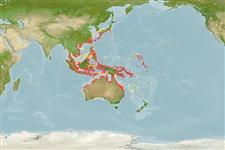Common names from other countries
Classification / Names / Names
俗名 | 同种异名 | Catalog of Fishes (gen., sp.) | ITIS | CoL | WoRMS
Environment: milieu / climate zone / depth range / distribution range
生态学
; 深度上下限 0 - 20 m (Ref. 343).
分布
国家 | FAO区域 | 生态系 | 标本纪录 | 简介
Indo-Pacific: Southeast Asia to Fiji and New Hebrides.
Length at first maturity / 大小 / 重量 / 年龄
Maturity: Lm ?, range 3 - 4.46 cm Max length : 5.0 cm CW 雄鱼/尚未辨别雌雄; (Ref. 343)
Carapace rounded, with 2 long, well-developed lateral spines; anterolateral margins gently serrated. Outer surface of palm with low but distinct oblique ridge. Color: yellowish ground color with numerous fine black spots and several larger ones on carapace; legs and chelae bright yellow.
Caught by local communities in nets, by hand or beach seines. On sandy areas (Ref. 343), and intertidal mudflats (Refs. 128960, 9773). Carnivorous and facultative scavengers. Preys mainly on crustaceans and mollusks; smaller individuals on small, soft-shelled species while larger individuals eat slow-moving invertebrates like anomurans, bivalves and gastropods (Ref. 102715). Scavenger-predator (Ref. 128960). Usually seen swimming along the tidal current. Known to burrow in sand (Ref. 9773).
Life cycle and mating behavior
成熟度 | 繁殖 | 产卵场 | 卵 | 孕卵数 | 仔鱼
Members of the order Decapoda are mostly gonochoric. Mating behavior: Precopulatory courtship ritual is common (through olfactory and tactile cues); usually indirect sperm transfer.
主要参考文献
参考文献 | 合作者 | 合作者
Ng, P.K.L. 1998. (Ref. 343)
世界自然保护联盟红皮书 (Ref. 130435)
Not Evaluated
Not Evaluated
对人类的威胁
人类利用
渔业: 自给性渔业
| FishSource |
工具
网络资源
Estimates based on models
Preferred temperature
(Ref.
115969): 22.8 - 29.3, mean 28.6 (based on 2487 cells).
脆弱性
Low vulnerability (10 of 100).
价格分类
Unknown.
